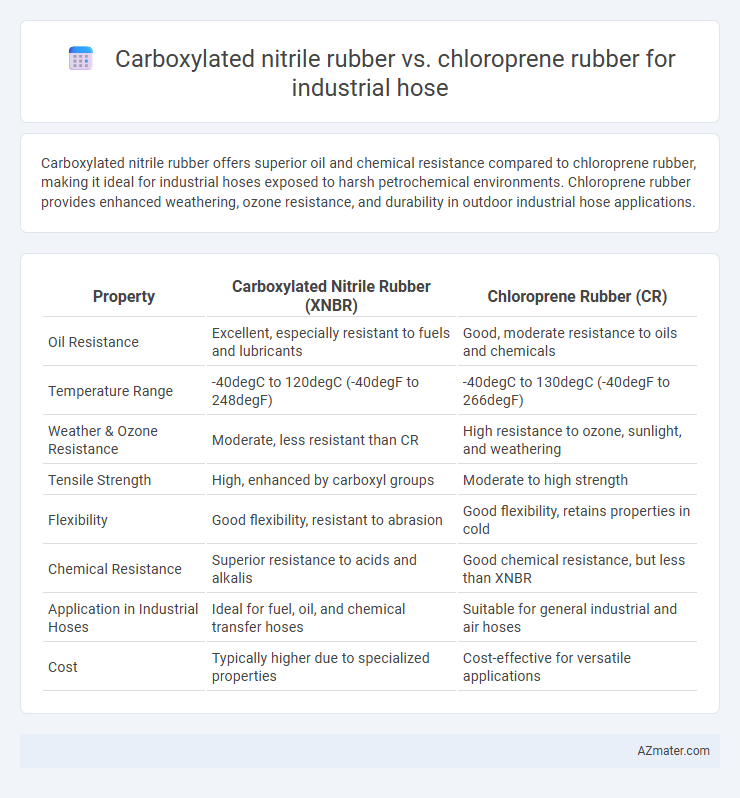Carboxylated nitrile rubber offers superior oil and chemical resistance compared to chloroprene rubber, making it ideal for industrial hoses exposed to harsh petrochemical environments. Chloroprene rubber provides enhanced weathering, ozone resistance, and durability in outdoor industrial hose applications.
Table of Comparison
| Property | Carboxylated Nitrile Rubber (XNBR) | Chloroprene Rubber (CR) |
|---|---|---|
| Oil Resistance | Excellent, especially resistant to fuels and lubricants | Good, moderate resistance to oils and chemicals |
| Temperature Range | -40degC to 120degC (-40degF to 248degF) | -40degC to 130degC (-40degF to 266degF) |
| Weather & Ozone Resistance | Moderate, less resistant than CR | High resistance to ozone, sunlight, and weathering |
| Tensile Strength | High, enhanced by carboxyl groups | Moderate to high strength |
| Flexibility | Good flexibility, resistant to abrasion | Good flexibility, retains properties in cold |
| Chemical Resistance | Superior resistance to acids and alkalis | Good chemical resistance, but less than XNBR |
| Application in Industrial Hoses | Ideal for fuel, oil, and chemical transfer hoses | Suitable for general industrial and air hoses |
| Cost | Typically higher due to specialized properties | Cost-effective for versatile applications |
Introduction to Industrial Hose Materials
Industrial hoses require materials with excellent chemical resistance, flexibility, and durability to withstand harsh operating conditions. Carboxylated nitrile rubber (XNBR) offers superior resistance to oils, fuels, and abrasion, making it ideal for applications involving petroleum-based fluids. Chloroprene rubber (CR), known for its balanced resistance to weathering, ozone, and moderate chemicals, provides excellent flexibility and mechanical strength suited for general-purpose industrial hose applications.
Overview of Carboxylated Nitrile Rubber (XNBR)
Carboxylated Nitrile Rubber (XNBR) offers superior abrasion resistance and improved tensile strength compared to traditional nitrile rubber, making it highly suitable for industrial hose applications requiring durability and flexibility. XNBR features enhanced oil, fuel, and chemical resistance due to its polar carboxyl groups, providing extended service life in harsh environments. Its outstanding resilience and low compression set contribute to maintaining hose integrity under high pressure and mechanical stress.
Key Properties of Chloroprene Rubber (CR)
Chloroprene rubber (CR) offers excellent resistance to weathering, ozone, and aging, making it a durable choice for industrial hoses exposed to harsh environmental conditions. Its moderate oil and chemical resistance combined with good physical toughness and flexibility ensure reliable performance in dynamic applications. CR hoses provide enhanced mechanical strength, abrasion resistance, and a balanced temperature range, outperforming carboxylated nitrile rubber (XNBR) in applications requiring long-term exposure to outdoor and industrial elements.
Comparative Chemical Resistance: XNBR vs. CR
Carboxylated nitrile rubber (XNBR) exhibits superior chemical resistance to oils, fuels, and solvents compared to chloroprene rubber (CR), making XNBR ideal for industrial hoses exposed to aggressive hydrocarbon environments. CR offers better resistance to weathering, ozone, and moderate acids but degrades faster when in contact with aromatics and alkalis. Selecting XNBR enhances hose longevity in petroleum-based applications, while CR remains preferred for general-purpose industrial use where environmental exposure is a concern.
Abrasion and Wear Performance
Carboxylated nitrile rubber (XNBR) exhibits superior abrasion resistance and wear performance compared to chloroprene rubber (CR), making it ideal for industrial hoses subjected to harsh mechanical stress. XNBR's enhanced tensile strength and resilience to surface degradation provide extended hose service life in abrasive environments. Chloroprene rubber offers good chemical resistance but generally falls short in sustained abrasion endurance relative to carboxylated nitrile formulations.
Oil and Fuel Resistance Analysis
Carboxylated nitrile rubber (XNBR) exhibits superior oil and fuel resistance compared to chloroprene rubber (CR) due to its enhanced polarity and cross-linking density, which improve resistance to swelling and degradation in hydrocarbon-rich environments. XNBR's molecular structure provides greater chemical stability against fuels, oils, and various hydrocarbons, making it ideal for industrial hoses exposed to aggressive petroleum products. In contrast, chloroprene rubber offers moderate oil resistance but tends to deteriorate faster under prolonged exposure to fuels, limiting its durability in demanding oil and fuel handling applications.
Temperature Stability and Environmental Suitability
Carboxylated nitrile rubber (XNBR) offers superior temperature stability, maintaining performance in a range from -40degC to 100degC, making it ideal for industrial hoses exposed to fluctuating temperatures. Chloroprene rubber (CR) exhibits excellent environmental suitability due to its outstanding resistance to ozone, weathering, and aging, ensuring durability in outdoor or harsh conditions. Both materials provide excellent chemical resistance, but XNBR excels in dynamic applications requiring enhanced abrasion resistance, while CR is preferred for long-term exposure to environmental stressors.
Mechanical Strength and Flexibility Comparison
Carboxylated nitrile rubber (XNBR) offers superior mechanical strength with enhanced tensile and abrasion resistance, making it ideal for high-pressure industrial hoses. Chloroprene rubber (CR) provides excellent overall flexibility and good resistance to weathering and ozone but typically exhibits lower tensile strength compared to XNBR. The choice depends on application needs, with XNBR favored for durability under stress and CR selected for flexible, weather-resistant hose applications.
Cost-effectiveness and Market Availability
Carboxylated nitrile rubber (XNBR) offers superior oil and abrasion resistance, making it cost-effective for industrial hoses exposed to harsh chemicals, while chloroprene rubber (CR) provides excellent weather and ozone resistance with moderate oil resistance at a generally lower price point. Market availability favors chloroprene rubber due to its long-standing use and large-scale production, ensuring easier procurement and competitive pricing. Choosing between XNBR and CR depends on specific application demands, balancing material performance against budget constraints and supply chain reliability.
Conclusion: Best Applications for XNBR and CR in Industrial Hoses
Carboxylated nitrile rubber (XNBR) is ideal for industrial hoses requiring excellent oil resistance, abrasion durability, and chemical stability, making it suitable for fuel lines, hydraulic hoses, and oil transfer applications. Chloroprene rubber (CR) excels in environments demanding superior weather, ozone, and flame resistance, often used in general purpose hoses, air and water transfer, and hoses exposed to outdoor elements. Selecting between XNBR and CR depends on the specific industrial application's exposure to oils, chemicals, and environmental conditions to ensure optimal hose performance and longevity.

Infographic: Carboxylated nitrile rubber vs Chloroprene rubber for Industrial hose
 azmater.com
azmater.com